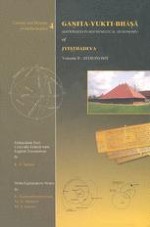2008 | Buch
Gaṇita-Yukti-Bhāṣā (Rationales in Mathematical Astronomy) of Jyeṣṭhadeva
Volume II - Astronomy
verfasst von: K. V. Sarma, K. Ramasubramanian, M. D. Srinivas, M. S. Sriram
Verlag: Hindustan Book Agency
Buchreihe : Culture and History of Mathematics
